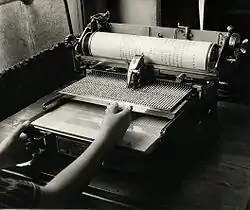Japanese typewriter
The first practical Japanese typewriter (Japanese: 和文タイプライター, Hepburn: wabun taipuraitā) was invented by Kyota Sugimoto in 1915. Out of the thousands of kanji characters, Kyota's original typewriter used 2,400 of them.[1] He obtained the patent rights to the typewriter that he invented in 1929.[2] Sugimoto's typewriter met its competition when the Oriental Typewriter was invented by Shimada Minokichi.[3] The Otani Japanese Typewriter Company and Toshiba also released their own typewriters later.[3]

The Japanese typewriter, however, was bulky and laborious to use. Unlike the English-language typewriter, which allows the typist to key in text quickly, one needed to locate and then retrieve the desired character from a large matrix of metal characters.[4] For instance, to type a sentence, the typist would need to find and retrieve around 22 symbols from about three different character matrices, making the sentence longer to type than its romanized version.[4] For this reason, typists are required to undergo specialized training and word processing was not part of the duties of the ordinary office workers.[4]
See also
References
- Obendorf, Hartmut (2009). Minimalism: Designing Simplicity. Dordrecht: Springer Science & Business Media. p. 114. ISBN 9781848823709.
- Japan Patent Office Archived 5 March 2011 at the Wayback Machine , Kyota Sugimoto (Japanese Typewriter), 28 January 2009.
- Mullaney, Thomas S. (2018). The Chinese Typewriter: A History. Cambridge, MA: MIT Press. p. 205. ISBN 9780262036368.
- Gottlieb, Nanette (2013). Word-Processing Technology in Japan: Kanji and the Keyboard. Oxon: Routledge. pp. 10–11. ISBN 978-0700712229.
External links
| Wikimedia Commons has media related to Japanese typewriters. |
- "Japanese Typewriters".
- 和文タイプライター "Japanese Typewriter" (Japanese)
- 和文タイプライター "Japanese Typewriter" (Japanese; archive of the above link)